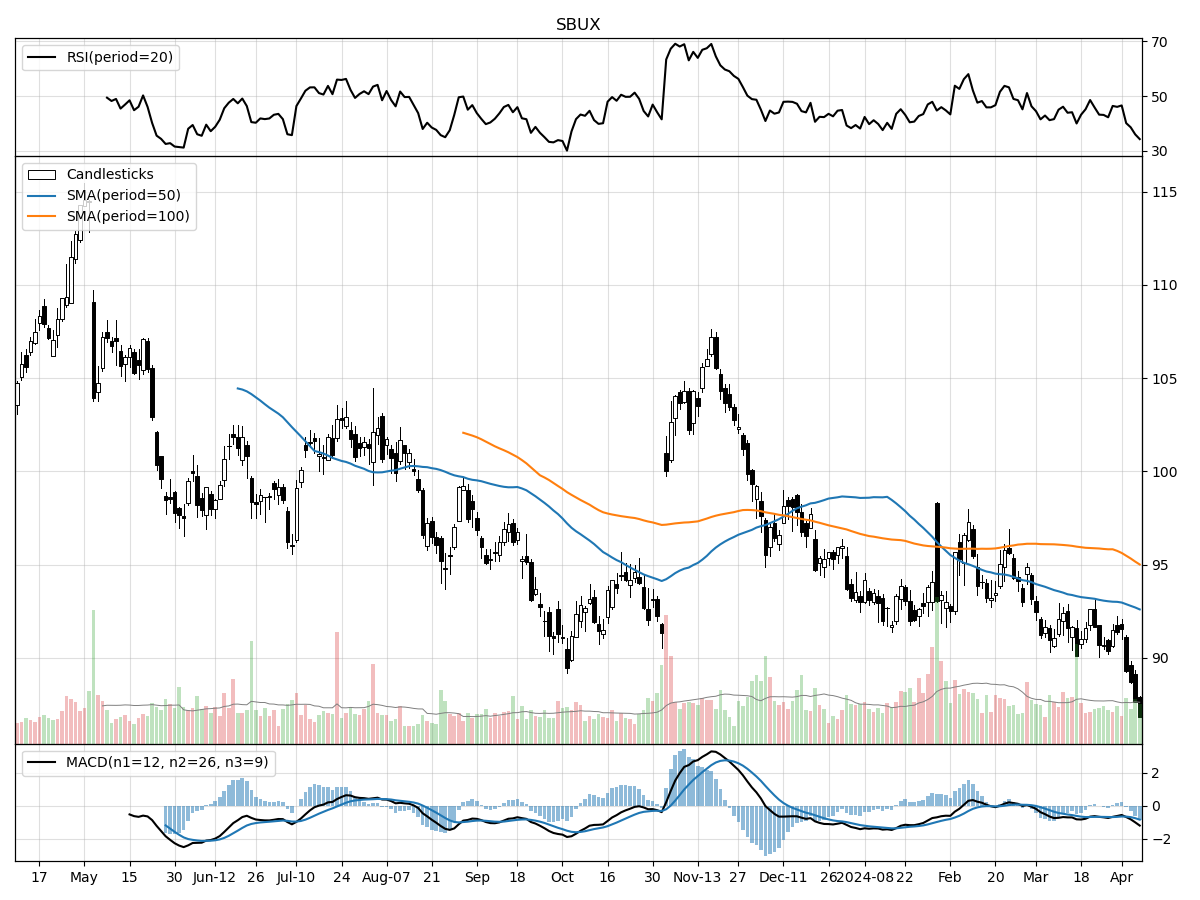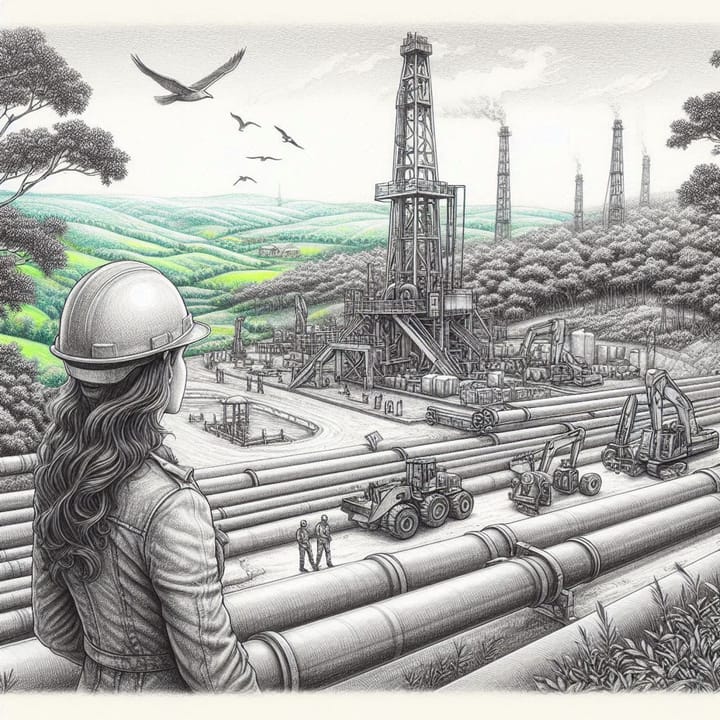Starbucks Corp. (SBUX), Large Cap AI Study of the Week

April 8, 2024
Weekly AI Pick from the S&P 500
Company Overview
Starbucks Corporation, recognized globally as a leading roaster, marketer, and retailer of specialty coffee, operates in 86 markets and trades on the Nasdaq with the ticker "SBUX." The company offers a diverse range of high-quality coffee, teas, beverages, and food items through its company-operated stores and licenses its trademarks in other channels, including grocery and foodservice sectors through a partnership with Nestlé. Starbucks places a strong emphasis on ethical sourcing, with over 98% of its coffee being ethically sourced, and is dedicated to the growth and innovation of its product line and store formats.
The company is also committed to human capital management, offering comprehensive benefits to its employees, such as paid parental leave, mental health programs, and continuous training in partnership with Arizona State University. Starbucks maintains 100% pay equity in the U.S. and is working towards global gender pay equity. It employs around 381,000 people globally, with a small percentage of U.S. store partners being unionized. The executive team is led by CEO Laxman Narasimhan.
Starbucks' revenue is divided into three main segments: North America (74%), International (21%), and Channel Development (5%). The International segment demands more support due to varying development stages, while the Channel Development segment includes products sold outside of Starbucks stores under licensing agreements, such as the Global Coffee Alliance with Nestlé. In fiscal 2023, the majority of Starbucks' revenue came from company-operated stores, with a focus on delivering a unique Starbucks Experience and expanding store presence. Licensed stores, which offer higher operating margins, accounted for 13% of total net revenues.
During fiscal 2023, Starbucks continued to expand its global presence, with licensed stores increasing by 988, totaling 18,446 stores worldwide. The company also focuses on digital enhancements, including mobile ordering and delivery. Starbucks secures its coffee supply through fixed and flexible price commitments and supports sustainable coffee production through its farmer support centers. Facing competition in retail and channel development segments, Starbucks relies on its product quality, brand reputation, and convenience to maintain its market position. The company's financial performance is seasonally affected, with higher cash flows in Q1 due to holiday sales, but this does not significantly impact annual earnings. Starbucks disseminates important information via its website, hosting corporate governance documents and other investor relations materials, but this content is not incorporated into its SEC filings.
By the Numbers
Total net revenues: $36.0 billion, a 12% increase from $32.3 billion the previous year.
- U.S. and International segments: Primary drivers of revenue growth.
- North America comparable store sales: 9% increase.
- Operating income: $5.9 billion, reflecting an operating margin of 16.3%.
- Capital expenditures: Increased to $2.3 billion.
- Shareholder returns: Decreased to $3.4 billion from $6.3 billion the previous year.
- North America revenues: Increased by $3.2 billion, a 14% increase.
- North America operating margin: Expanded by 150 basis points to 20.7%.
- International segment revenue: Rose by $548 million, a 7.9% increase.
- International segment operating income: Soared by 48% to $1.2 billion.
- International segment operating margin: Improved by 440 basis points.
- Channel Development segment revenue: Increased by $50 million (3%).
- Channel Development segment operating income: Rose by 18% to $968 million.
- Corporate and Other operating loss: $1.8 billion, a 20% increase from the previous year.
- Cash and investments: Ended the fiscal year with $4.2 billion.
- Effective tax rate: Increased slightly from 22.4% to 23.6%.
- Liquidity: $2.5 billion in cash and short-term investments held overseas.
- Unsecured revolving credit facility: $3.0 billion, with an option to increase by $1.0 billion.
- Commercial paper program: $3.0 billion limit, no borrowings outstanding.
- Japan credit facilities: Utilized ¥5 billion.
- Operating cash flows: Increased to $6.0 billion from $4.4 billion.
- Investing activities: Consumed $2.3 billion.
- Financing activities: Used $3.0 billion, a decrease from $5.6 billion.
- Market risks: Hedging against commodities like green coffee and dairy.
- Sensitivity analyses: A 10% change in commodity prices, foreign exchange rates, or interest rates could impact earnings.
- Critical accounting estimates: Detailed in Note 1 of the 10-K, consistent over the past five fiscal years.
- Income tax considerations: Deferred tax assets and liabilities, uncertain tax positions, and repatriation of foreign earnings.
- Property, plant, and equipment: Assessing impairment based on future cash flows and fair values.
- Goodwill and indefinite-lived intangible assets: Annual impairment review or when potential impairment is indicated.
Stock Performance and Technical Analysis

Upon analyzing the provided technical indicators for the stock in question, we can infer several key aspects of its current market behavior and sentiment. The stock price stability over the last month, coupled with a 7.11% decline over the past three months, suggests that while short-term volatility may not be of significant concern, there has been a noticeable downward trend in the medium term. This could be indicative of a bearish sentiment or reaction to specific company or market events.
The stock's current price being 24% below its 52-week high and at its 52-week low indicates that it has retreated significantly from its peak level over the last year. This could be interpreted as the stock being undervalued or it could also signal underlying issues within the company or a general market downturn affecting the stock. Investors often consider stocks trading near their lows as potential 'value buys,' but it is crucial to ascertain whether the low price is due to temporary factors or more systemic issues within the company.
The Money Flow indicators suggesting moderate selling pressure and distribution imply that there is a net outflow of money from the stock, which is a bearish sign. When more investors are selling a stock than buying, it can drive the price down, reflecting a lack of confidence or a shift towards a bearish outlook. Furthermore, the Moving Average Convergence Divergence (MACD) being bearish at -0.85 reinforces this sentiment, as the MACD is a trend-following momentum indicator that shows the relationship between two moving averages of a stock's price. A negative MACD indicates that the short-term average is below the long-term average, signaling downward price momentum and potentially more declines ahead.
In summary, the technical analysis suggests a cautious approach to investing in this stock. With the recent downward trend, selling pressure, and a bearish MACD, there could be further downside risks. However, as with any investment decision, it would be prudent to also consider fundamental analysis, reviewing the company's financial health, industry position, and potential growth prospects before making a final decision. Additionally, external market factors and news that could affect the stock should be taken into account to provide a more comprehensive analysis.

The ‘Bull’ Perspective
Starbucks Corp (SBUX): A Robust Buy Amidst Economic Challenges
Upfront Summary:
- Resilient Business Model: Despite the pandemic, Starbucks has shown a robust recovery, with a 31% increase in consolidated net revenues to $29.1 billion in fiscal 2021, indicating a strong rebound from 2020.
- Strategic Expansion: Starbucks continues its aggressive expansion with plans to open approximately 2,000 new stores globally in fiscal 2022, focusing on high-growth markets like China, where the store count has grown by nearly 17% since 2020.
- Digital Innovation and Loyalty Programs: The Starbucks Rewards loyalty program has grown to 24.2 million active members, driving digital sales and customer retention, with mobile orders accounting for 26% of U.S. company-operated transactions.
- Sustainable Supply Chain and Ethical Sourcing: Starbucks is committed to ethical sourcing, with 99% of its coffee being ethically sourced, and it has invested in supply chain resilience, which is crucial amidst global disruptions.
- Financial Strength and Shareholder Value: The company's strong financial position is reflected in its $4.2 billion in cash flow from operations and plans to return $20 billion to shareholders through buybacks and dividends over the next three years.
Detailed Analysis:
- Resilient Business Model:
Starbucks Corp has demonstrated exceptional resilience in the face of global economic headwinds. The company's ability to bounce back with a 31% increase in consolidated net revenues to $29.1 billion in fiscal 2021 is a testament to its solid business model and adaptability. This recovery is not just a rebound from the pandemic lows of 2020; it's a reflection of the company's enduring appeal and operational excellence. Despite the identified risks, such as the ongoing pandemic and supply chain challenges, Starbucks has managed to maintain its market position and grow its revenue, showcasing the strength and appeal of its brand even in tough economic times. - Strategic Expansion:
Starbucks' strategic growth plan is firing on all cylinders, particularly with its focus on international expansion. The company plans to inaugurate around 2,000 new stores globally in fiscal 2022, with a keen eye on China—a market that has seen a nearly 17% increase in store count since 2020. This aggressive expansion strategy highlights Starbucks' confidence in its global brand appeal and its ability to capture significant market share in emerging economies. The expansion is not just about quantity; it's about strategic locations and tapping into new customer bases, which will drive future revenue growth. - Digital Innovation and Loyalty Programs:
The Starbucks Rewards loyalty program is a cornerstone of the company's digital strategy, boasting 24.2 million active members—a clear indicator of the brand's customer engagement success. This loyalty program, coupled with the fact that mobile orders constitute 26% of U.S. company-operated transactions, underscores the company's innovative approach to technology and customer service. These digital platforms not only enhance customer experiences but also create valuable data-driven insights, allowing Starbucks to tailor offerings and drive sales efficiently. - Sustainable Supply Chain and Ethical Sourcing:
Ethical sourcing and sustainability are at the heart of Starbucks' operations, with 99% of its coffee being ethically sourced. The company's commitment to a sustainable supply chain is particularly significant in the current global climate of supply disruptions. By investing in supply chain resilience and ethical practices, Starbucks is not only securing its operations against global risks but also strengthening its brand reputation and customer loyalty—a crucial advantage in the competitive coffee industry. - Financial Strength and Shareholder Value:
Starbucks' financial health is robust, as evidenced by its $4.2 billion in cash flow from operations. This financial strength enables the company to pursue aggressive share buybacks and dividend payments, with plans to return $20 billion to shareholders over the next three years. This commitment to shareholder value, even amidst economic uncertainties and inflationary pressures, signals confidence in the company's future performance and its ability to generate ample cash flows to support these initiatives.
Conclusion:
In conclusion, Starbucks Corp presents a compelling investment opportunity. The company's proven resilience, strategic growth initiatives, digital innovation, commitment to sustainability, and strong financial position equip it to navigate through economic challenges and capitalize on growth opportunities. While risks such as inflation, labor costs, and geopolitical tensions remain, Starbucks' strategic maneuvers and operational strengths position it as a robust buy for investors looking for a blend of growth, stability, and shareholder returns.

The ‘Bear’ Perspective
Why Investors Should Steer Clear of Starbucks Corp (SBUX) Stock
Summary:
- Overreliance on the North American Market: Starbucks generates approximately 74% of its net revenue from North America, making it highly susceptible to regional economic downturns.
- Vulnerability to International Tensions and Market Dynamics: The company's aggressive expansion in China places it at risk due to geopolitical tensions and a highly competitive market.
- Supply Chain and Commodity Price Risks: Starbucks is subject to the volatility of arabica coffee bean prices and supply chain disruptions, which can significantly impact its cost structure.
- Labor Challenges and Unionization Movements: Labor cost fluctuations and unionization efforts could lead to increased operational expenses and reduced flexibility.
- Regulatory and Climate Change Risks: Compliance with evolving regulations and the effects of climate change on coffee sourcing could lead to higher costs and operational disruptions.
Elaboration on Points:
- Overreliance on the North American Market
The fact that Starbucks draws a massive 74% of its total net revenue from North America is a double-edged sword. While it indicates strong market dominance, it also exposes the company to regional economic fluctuations. Any downturn in the U.S. economy, such as a recession or a decline in consumer spending, could disproportionately affect Starbucks' financial performance. Additionally, saturation in the North American market could limit growth prospects and lead to an overdependence on existing stores to drive revenue, which is not sustainable in the long term. - Vulnerability to International Tensions and Market Dynamics
Starbucks' expansion into China, aiming to capitalize on the growing middle class and their increasing coffee consumption, is fraught with risks. The ongoing U.S.-China tensions could lead to regulatory retaliation, affecting Starbucks' operations. Moreover, the Chinese market is highly competitive with local players like Luckin Coffee, which could erode Starbucks' market share. As of now, the Chinese market is a significant growth driver for Starbucks, but the political and competitive landscape makes it a volatile bet. - Supply Chain and Commodity Price Risks
The price and availability of high-quality arabica coffee beans are critical to Starbucks' business model. Fluctuations in commodity markets can lead to unpredictable costs, and Starbucks may not always be able to pass these costs onto consumers. Supply chain disruptions, whether from natural disasters, political instability, or trade restrictions, can further exacerbate these risks. Such disruptions could result in store closures, limited product offerings, and ultimately, a decline in sales and profitability. - Labor Challenges and Unionization Movements
Starbucks faces significant labor market risks, including wage inflation and a tight labor market. The recent moves towards unionization among Starbucks employees could result in higher wages and benefits, increasing operational costs. Additionally, unionization efforts could limit the company's operational flexibility, affecting its ability to quickly adapt to market changes. These factors combined could squeeze margins and reduce the company's competitiveness. - Regulatory and Climate Change Risks
Regulatory compliance, particularly with environmental, social, and governance (ESG) initiatives, is becoming increasingly complex and costly. Starbucks must navigate these regulations carefully to avoid penalties and maintain its brand reputation. Climate change presents a direct threat to Starbucks' coffee supply chain, as changing weather patterns can affect crop yields and quality. The company may face higher costs and supply shortages as it strives to source sustainably, which could impact its long-term profitability.
Conclusion:
Considering the substantial risks associated with Starbucks Corp, from its dependency on the North American market to the myriad of global operational challenges, investors should be cautious. The potential for regional economic downturns, geopolitical tensions, supply chain volatility, labor disputes, and regulatory pressures all suggest that Starbucks' current stock valuation may not fully account for these risks. Prudent investors should weigh these factors heavily when considering the purchase, sale, or short position in Starbucks shares.




Comments ()